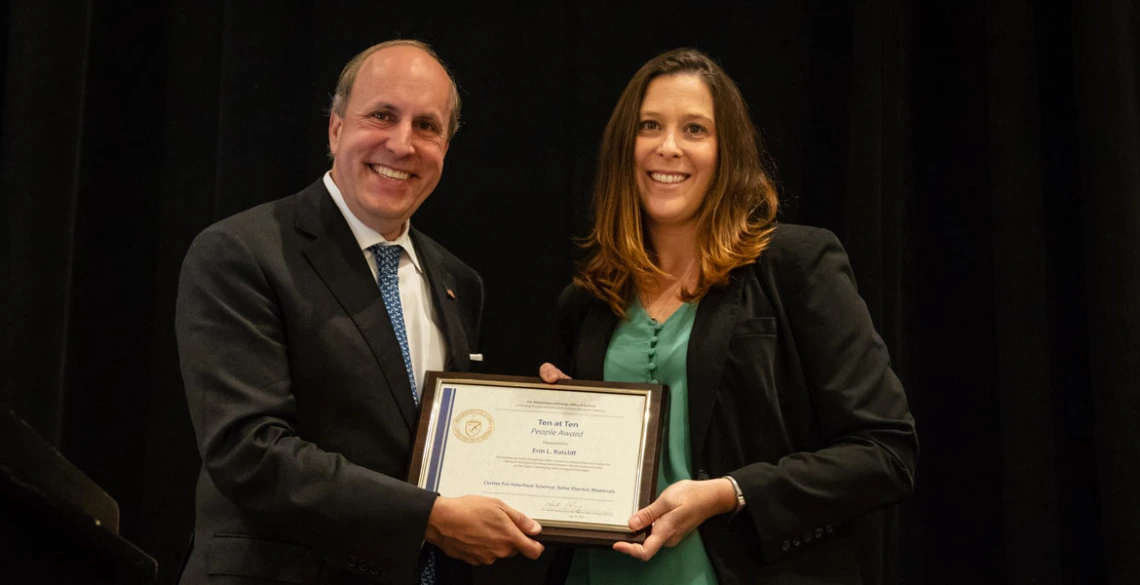Assistant Professor Unites Energy Researchers Across Nation
Erin Ratcliff was one of only three individuals to receive national recognition for her involvement with the DOE’s Energy Frontier Research Centers.

Assistant professor Erin Ratcliff with Department of Energy Under Secretary for Science Paul Dabber at the 2019 Energy Frontier Research Centers Principal Investigators Meeting.
Erin Ratcliff has long been a proponent of working across disciplines. The University of Arizona assistant professor of materials science and engineering first came to the UA as a postdoctoral researcher in chemistry, working in a lab run by Neal Armstrong, UA Regents’ Professor of chemistry, biochemistry and optical sciences. Even her role as an interface electrochemist encompasses two areas of study: These experts consider both the chemical and electrical behaviors of materials.
“It’s harder to have a big impact when it’s just me and my research group limited to our capabilities and areas of expertise,” said Ratcliff, who runs the Laboratory for Interface Science of Printable Electronic Materials. “If you connect with people from a variety of different disciplines, you can ask and answer bigger, much more global questions through your research.”
So, in 2009 when the U.S. Department of Energy awarded the UA $15 million to lead the Center for Interface Science: Solar Electric Materials, or CISSEM, Armstrong, as the center director, decided she’d be a perfect fit to work on the project. The center was part of the Energy Frontier Research Centers program, a $777 million effort to develop improved methods for storing, collecting and using energy.
In honor of the centers’ 10-year anniversary, the DOE Office of Basic Energy Sciences reviewed the 82 centers, 1,600 senior investigators and 5,400 students across 170 institutions involved in the program over the last decade. The office recognized 10 groups of researchers or individual researchers who exemplified the centers’ mission. Ratcliff was one of them. Three of the Ten at Ten awards went to technologies and tools, four to scientific ideas and only three to individuals.
“When I heard about these awards, I contacted them and said, ‘We’ve got probably the poster child of what these EFRCs are supposed to produce, in terms of career development,’” said Armstrong, who nominated Ratcliff for the honor. “She’s just such a huge success story.”
Stitching Together Disparate Groups
CISSEM -- a collaboration between the UA, Georgia Institute of Technology, National Renewable Energy Laboratory, Princeton University and the University of Washington -- existed from 2009 to 2014. The center focused on using organic molecules to convert sunlight into electricity.
“It’s been 10 years since our center started, and that my work is being recognized as being so instrumental even that far afterward is a tremendous honor,” Ratcliff said. “We created a set of design guidelines that have transcended our center. Even now, there are centers interested in solar energy or batteries and many different types of processes that still have foundations in and connections to what we did.”
She’s pretty fabulous. A real role model for women in engineering and for what it takes to be successful in this modern funding world.”
Armstrong said Ratcliff was like the glue that held the parts of the center together. She traveled between sites, led the development of a lexicon everyone involved could understand, and often worked on papers with four or five groups at a time.
“She was the person who had the motivation and the instincts to stitch these disparate groups together with her scientific activities and her personality,” Armstrong said. “She’s pretty fabulous. A real role model for women in engineering and for what it takes to be successful in this modern funding world.”
Beyond Center’s End
Ratcliff’s research has indeed reached impressive heights since the end of the center in 2014. She’s published dozens of papers on everything from solar cells to bioelectronics. In 2016, she collaborated with Jeanne Pemberton, a UA Regents’ Professor of chemistry and biochemistry in the College of Science, on a National Science Foundation grant to improve the viability of organic semiconductor materials. The two first met while working at CISSEM.
“Erin is one of the most inherently multidisciplinary, collaborative new young investigators that I know of, and I am thrilled that she has been chosen by the DOE for this award,” Pemberton said. “She exemplifies the skill set and multidisciplinary approach of the successful STEM faculty member of the future, and we are lucky to have her as a colleague here at the UA.”


